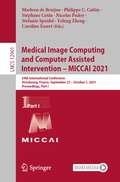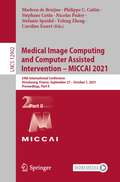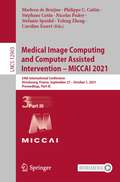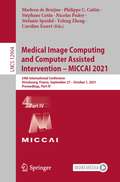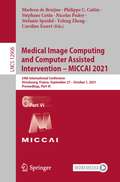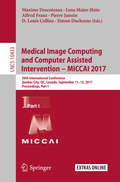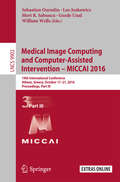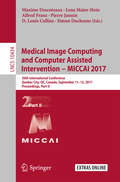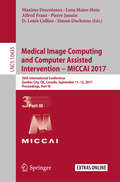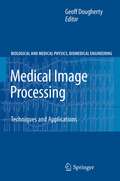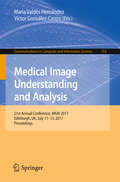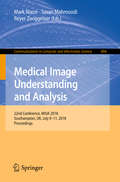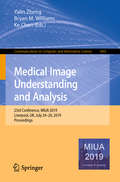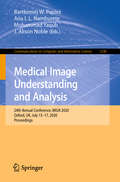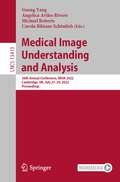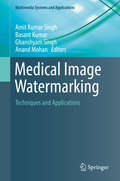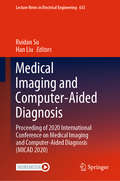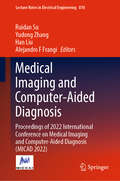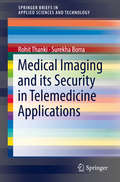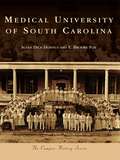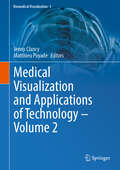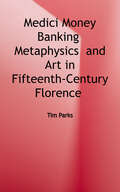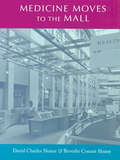- Table View
- List View
Medical Image Computing and Computer Assisted Intervention – MICCAI 2021: 24th International Conference, Strasbourg, France, September 27–October 1, 2021, Proceedings, Part I (Lecture Notes in Computer Science #12901)
by Yefeng Zheng Stéphane Cotin Caroline Essert Stefanie Speidel Philippe C. Cattin Marleen De Bruijne Nicolas PadoyThe eight-volume set LNCS 12901, 12902, 12903, 12904, 12905, 12906, 12907, and 12908 constitutes the refereed proceedings of the 24th International Conference on Medical Image Computing and Computer-Assisted Intervention, MICCAI 2021, held in Strasbourg, France, in September/October 2021.*The 542 revised full papers presented were carefully reviewed and selected from 1809 submissions in a double-blind review process. The papers are organized in the following topical sections: Part I: image segmentation Part II: machine learning - self-supervised learning; machine learning - semi-supervised learning; and machine learning - weakly supervised learning Part III: machine learning - advances in machine learning theory; machine learning - domain adaptation; machine learning - federated learning; machine learning - interpretability / explainability; and machine learning - uncertainty Part IV: image registration; image-guided interventions and surgery; surgical data science; surgical planning and simulation; surgical skill and work flow analysis; and surgical visualization and mixed, augmented and virtual reality Part V: computer aided diagnosis; integration of imaging with non-imaging biomarkers; and outcome/disease prediction Part VI: image reconstruction; clinical applications - cardiac; and clinical applications - vascular Part VII: clinical applications - abdomen; clinical applications - breast; clinical applications - dermatology; clinical applications - fetal imaging; clinical applications - lung; clinical applications - neuroimaging - brain development; clinical applications - neuroimaging - DWI and tractography; clinical applications - neuroimaging - functional brain networks; clinical applications - neuroimaging – others; and clinical applications - oncology Part VIII: clinical applications - ophthalmology; computational (integrative) pathology; modalities - microscopy; modalities - histopathology; and modalities - ultrasound*The conference was held virtually.
Medical Image Computing and Computer Assisted Intervention – MICCAI 2021: 24th International Conference, Strasbourg, France, September 27–October 1, 2021, Proceedings, Part II (Lecture Notes in Computer Science #12902)
by Yefeng Zheng Stéphane Cotin Caroline Essert Stefanie Speidel Philippe C. Cattin Marleen De Bruijne Nicolas PadoyThe eight-volume set LNCS 12901, 12902, 12903, 12904, 12905, 12906, 12907, and 12908 constitutes the refereed proceedings of the 24th International Conference on Medical Image Computing and Computer-Assisted Intervention, MICCAI 2021, held in Strasbourg, France, in September/October 2021.*The 542 revised full papers presented were carefully reviewed and selected from 1809 submissions in a double-blind review process. The papers are organized in the following topical sections: Part I: image segmentation Part II: machine learning - self-supervised learning; machine learning - semi-supervised learning; and machine learning - weakly supervised learning Part III: machine learning - advances in machine learning theory; machine learning - domain adaptation; machine learning - federated learning; machine learning - interpretability / explainability; and machine learning - uncertainty Part IV: image registration; image-guided interventions and surgery; surgical data science; surgical planning and simulation; surgical skill and work flow analysis; and surgical visualization and mixed, augmented and virtual reality Part V: computer aided diagnosis; integration of imaging with non-imaging biomarkers; and outcome/disease prediction Part VI: image reconstruction; clinical applications - cardiac; and clinical applications - vascular Part VII: clinical applications - abdomen; clinical applications - breast; clinical applications - dermatology; clinical applications - fetal imaging; clinical applications - lung; clinical applications - neuroimaging - brain development; clinical applications - neuroimaging - DWI and tractography; clinical applications - neuroimaging - functional brain networks; clinical applications - neuroimaging – others; and clinical applications - oncology Part VIII: clinical applications - ophthalmology; computational (integrative) pathology; modalities - microscopy; modalities - histopathology; and modalities - ultrasound*The conference was held virtually.
Medical Image Computing and Computer Assisted Intervention – MICCAI 2021: 24th International Conference, Strasbourg, France, September 27–October 1, 2021, Proceedings, Part III (Lecture Notes in Computer Science #12903)
by Yefeng Zheng Stéphane Cotin Caroline Essert Stefanie Speidel Philippe C. Cattin Marleen De Bruijne Nicolas PadoyThe eight-volume set LNCS 12901, 12902, 12903, 12904, 12905, 12906, 12907, and 12908 constitutes the refereed proceedings of the 24th International Conference on Medical Image Computing and Computer-Assisted Intervention, MICCAI 2021, held in Strasbourg, France, in September/October 2021.*The 542 revised full papers presented were carefully reviewed and selected from 1809 submissions in a double-blind review process. The papers are organized in the following topical sections: Part I: image segmentation Part II: machine learning - self-supervised learning; machine learning - semi-supervised learning; and machine learning - weakly supervised learning Part III: machine learning - advances in machine learning theory; machine learning - domain adaptation; machine learning - federated learning; machine learning - interpretability / explainability; and machine learning - uncertainty Part IV: image registration; image-guided interventions and surgery; surgical data science; surgical planning and simulation; surgical skill and work flow analysis; and surgical visualization and mixed, augmented and virtual reality Part V: computer aided diagnosis; integration of imaging with non-imaging biomarkers; and outcome/disease prediction Part VI: image reconstruction; clinical applications - cardiac; and clinical applications - vascular Part VII: clinical applications - abdomen; clinical applications - breast; clinical applications - dermatology; clinical applications - fetal imaging; clinical applications - lung; clinical applications - neuroimaging - brain development; clinical applications - neuroimaging - DWI and tractography; clinical applications - neuroimaging - functional brain networks; clinical applications - neuroimaging – others; and clinical applications - oncology Part VIII: clinical applications - ophthalmology; computational (integrative) pathology; modalities - microscopy; modalities - histopathology; and modalities - ultrasound*The conference was held virtually.
Medical Image Computing and Computer Assisted Intervention – MICCAI 2021: 24th International Conference, Strasbourg, France, September 27–October 1, 2021, Proceedings, Part IV (Lecture Notes in Computer Science #12904)
by Yefeng Zheng Stéphane Cotin Caroline Essert Stefanie Speidel Philippe C. Cattin Marleen De Bruijne Nicolas PadoyThe eight-volume set LNCS 12901, 12902, 12903, 12904, 12905, 12906, 12907, and 12908 constitutes the refereed proceedings of the 24th International Conference on Medical Image Computing and Computer-Assisted Intervention, MICCAI 2021, held in Strasbourg, France, in September/October 2021.*The 542 revised full papers presented were carefully reviewed and selected from 1809 submissions in a double-blind review process. The papers are organized in the following topical sections: Part I: image segmentation Part II: machine learning - self-supervised learning; machine learning - semi-supervised learning; and machine learning - weakly supervised learning Part III: machine learning - advances in machine learning theory; machine learning - domain adaptation; machine learning - federated learning; machine learning - interpretability / explainability; and machine learning - uncertainty Part IV: image registration; image-guided interventions and surgery; surgical data science; surgical planning and simulation; surgical skill and work flow analysis; and surgical visualization and mixed, augmented and virtual reality Part V: computer aided diagnosis; integration of imaging with non-imaging biomarkers; and outcome/disease prediction Part VI: image reconstruction; clinical applications - cardiac; and clinical applications - vascular Part VII: clinical applications - abdomen; clinical applications - breast; clinical applications - dermatology; clinical applications - fetal imaging; clinical applications - lung; clinical applications - neuroimaging - brain development; clinical applications - neuroimaging - DWI and tractography; clinical applications - neuroimaging - functional brain networks; clinical applications - neuroimaging – others; and clinical applications - oncology Part VIII: clinical applications - ophthalmology; computational (integrative) pathology; modalities - microscopy; modalities - histopathology; and modalities - ultrasound*The conference was held virtually.
Medical Image Computing and Computer Assisted Intervention – MICCAI 2021: 24th International Conference, Strasbourg, France, September 27–October 1, 2021, Proceedings, Part VI (Lecture Notes in Computer Science #12906)
by Yefeng Zheng Stéphane Cotin Caroline Essert Stefanie Speidel Philippe C. Cattin Marleen De Bruijne Nicolas PadoyThe eight-volume set LNCS 12901, 12902, 12903, 12904, 12905, 12906, 12907, and 12908 constitutes the refereed proceedings of the 24th International Conference on Medical Image Computing and Computer-Assisted Intervention, MICCAI 2021, held in Strasbourg, France, in September/October 2021.*The 531 revised full papers presented were carefully reviewed and selected from 1630 submissions in a double-blind review process. The papers are organized in the following topical sections: Part I: image segmentation Part II: machine learning - self-supervised learning; machine learning - semi-supervised learning; and machine learning - weakly supervised learning Part III: machine learning - advances in machine learning theory; machine learning - attention models; machine learning - domain adaptation; machine learning - federated learning; machine learning - interpretability / explainability; and machine learning - uncertainty Part IV: image registration; image-guided interventions and surgery; surgical data science; surgical planning and simulation; surgical skill and work flow analysis; and surgical visualization and mixed, augmented and virtual reality Part V: computer aided diagnosis; integration of imaging with non-imaging biomarkers; and outcome/disease prediction Part VI: image reconstruction; clinical applications - cardiac; and clinical applications - vascular Part VII: clinical applications - abdomen; clinical applications - breast; clinical applications - dermatology; clinical applications - fetal imaging; clinical applications - lung; clinical applications - neuroimaging - brain development; clinical applications - neuroimaging - DWI and tractography; clinical applications - neuroimaging - functional brain networks; clinical applications - neuroimaging – others; and clinical applications - oncology Part VIII: clinical applications - ophthalmology; computational (integrative) pathology; modalities - microscopy; modalities - histopathology; and modalities - ultrasound*The conference was held virtually.
Medical Image Computing and Computer Assisted Intervention − MICCAI 2017: 20th International Conference, Quebec City, QC, Canada, September 11-13, 2017, Proceedings, Part I (Lecture Notes in Computer Science #10433)
by Pierre Jannin Maxime Descoteaux Lena Maier-Hein Alfred Franz D. Louis Collins Simon DuchesneThe three-volume set LNCS 10433, 10434, and 10435 constitutes the refereed proceedings of the 20th International Conference on Medical Image Computing and Computer-Assisted Intervention, MICCAI 2017, held in Quebec City, Canada, in September 2017. The 255 revised full papers presented were carefully reviewed and selected from 800 submissions in a two-phase review process. The papers have been organized in the following topical sections: Part I: atlas and surface-based techniques; shape and patch-based techniques; registration techniques, functional imaging, connectivity, and brain parcellation; diffusion magnetic resonance imaging (dMRI) and tensor/fiber processing; and image segmentation and modelling. Part II: optical imaging; airway and vessel analysis; motion and cardiac analysis; tumor processing; planning and simulation for medical interventions; interventional imaging and navigation; and medical image computing. Part III: feature extraction and classification techniques; and machine learning in medical image computing.
Medical Image Computing and Computer-Assisted Intervention - MICCAI 2016: 19th International Conference, Athens, Greece, October 17-21, 2016, Proceedings, Part III (Lecture Notes in Computer Science #9902)
by William Wells Sebastien Ourselin Leo Joskowicz Mert R. Sabuncu Gozde UnalThe three-volume set LNCS 9900, 9901, and 9902 constitutes the refereed proceedings of the 19th International Conference on Medical Image Computing and Computer-Assisted Intervention, MICCAI 2016, held in Athens, Greece, in October 2016. Based on rigorous peer reviews, the program committee carefully selected 228 revised regular papers from 756 submissions for presentation in three volumes. The papers have been organized in the following topical sections: Part I: brain analysis, brain analysis - connectivity; brain analysis - cortical morphology; Alzheimer disease; surgical guidance and tracking; computer aided interventions; ultrasound image analysis; cancer image analysis; Part II: machine learning and feature selection; deep learning in medical imaging; applications of machine learning; segmentation; cell image analysis; Part III: registration and deformation estimation; shape modeling; cardiac and vascular image analysis; image reconstruction; and MR image analysis.
Medical Image Computing and Computer-Assisted Intervention − MICCAI 2017: 20th International Conference, Quebec City, QC, Canada, September 11-13, 2017, Proceedings, Part II (Lecture Notes in Computer Science #10434)
by Pierre Jannin Maxime Descoteaux Lena Maier-Hein Alfred Franz D. Louis Collins Simon DuchesneThe three-volume set LNCS 10433, 10434, and 10435 constitutes the refereed proceedings of the 20th International Conference on Medical Image Computing and Computer-Assisted Intervention, MICCAI 2017, held in Quebec City, Canada, in September 2017. The 255 revised full papers presented were carefully reviewed and selected from 800 submissions in a two-phase review process. The papers have been organized in the following topical sections: Part I: atlas and surface-based techniques; shape and patch-based techniques; registration techniques, functional imaging, connectivity, and brain parcellation; diffusion magnetic resonance imaging (dMRI) and tensor/fiber processing; and image segmentation and modelling. Part II: optical imaging; airway and vessel analysis; motion and cardiac analysis; tumor processing; planning and simulation for medical interventions; interventional imaging and navigation; and medical image computing. Part III: feature extraction and classification techniques; and machine learning in medical image computing.
Medical Image Computing and Computer-Assisted Intervention − MICCAI 2017: 20th International Conference, Quebec City, QC, Canada, September 11-13, 2017, Proceedings, Part III (Lecture Notes in Computer Science #10435)
by Pierre Jannin Maxime Descoteaux Lena Maier-Hein Alfred Franz D. Louis Collins Simon DuchesneThe three-volume set LNCS 10433, 10434, and 10435 constitutes the refereed proceedings of the 20th International Conference on Medical Image Computing and Computer-Assisted Intervention, MICCAI 2017, held in Quebec City, Canada, in September 2017. The 255 revised full papers presented were carefully reviewed and selected from 800 submissions in a two-phase review process. The papers have been organized in the following topical sections: Part I: atlas and surface-based techniques; shape and patch-based techniques; registration techniques, functional imaging, connectivity, and brain parcellation; diffusion magnetic resonance imaging (dMRI) and tensor/fiber processing; and image segmentation and modelling. Part II: optical imaging; airway and vessel analysis; motion and cardiac analysis; tumor processing; planning and simulation for medical interventions; interventional imaging and navigation; and medical image computing. Part III: feature extraction and classification techniques; and machine learning in medical image computing.
Medical Image Processing
by Geoff DoughertyThe book is designed for end users in the field of digital imaging, who wish to update their skills and understanding with the latest techniques in image analysis. The book emphasizes the conceptual framework of image analysis and the effective use of image processing tools. It uses applications in a variety of fields to demonstrate and consolidate both specific and general concepts, and to build intuition, insight and understanding. Although the chapters are essentially self-contained they reference other chapters to form an integrated whole. Each chapter employs a pedagogical approach to ensure conceptual learning before introducing specific techniques and "tricks of the trade". The book concentrates on a number of current research applications, and will present a detailed approach to each while emphasizing the applicability of techniques to other problems. The field of topics is wide, ranging from compressive (non-uniform) sampling in MRI, through automated retinal vessel analysis to 3-D ultrasound imaging and more. The book is amply illustrated with figures and applicable medical images. The reader will learn the techniques which experts in the field are currently employing and testing to solve particular research problems, and how they may be applied to other problems.
Medical Image Understanding and Analysis: 21st Annual Conference, MIUA 2017, Edinburgh, UK, July 11–13, 2017, Proceedings (Communications in Computer and Information Science #723)
by María Valdés Hernández Víctor González-CastroThis book constitutes the refereed proceedings of the 21st Annual Conference on Medical Image Understanding and Analysis, MIUA 2017, held in Edinburgh, UK, in July 2017.The 82 revised full papers presented were carefully reviewed and selected from 105 submissions. The papers are organized in topical sections on retinal imaging, ultrasound imaging, cardiovascular imaging, oncology imaging, mammography image analysis, image enhancement and alignment, modeling and segmentation of preclinical, body and histological imaging, feature detection and classification.The chapters 'Model-Based Correction of Segmentation Errors in Digitised Histological Images' and 'Unsupervised Superpixel-Based Segmentation of Histopathological Images with Consensus Clustering' are open access under a CC BY 4.0 license.
Medical Image Understanding and Analysis: 22nd Conference, Miua 2018, Southampton, Uk, July 9-11, 2018, Revised Selected Papers (Communications In Computer And Information Science #894)
by Mark Nixon Reyer Zwiggelaar Sasan MahmoodiThis book constitutes the refereed proceedings of the 22st Annual Conference on Medical Image Understanding and Analysis, MIUA 2018, held in Southampton, UK, in July 2018.The 34 revised full papers presented were carefully reviewed and selected from 49 submissions. The papers are organized in topical sections on liver analysis, medical image analysis, texture and image analysis, MRI: applications and techniques, segmentation in medical images, CT: learning and planning, ocular imaging analysis, applications of medical image analysis.
Medical Image Understanding and Analysis: 23rd Conference, MIUA 2019, Liverpool, UK, July 24–26, 2019, Proceedings (Communications in Computer and Information Science #1065)
by Ke Chen Yalin Zheng Bryan M. WilliamsThis book constitutes the refereed proceedings of the 23rd Conference on Medical Image Understanding and Analysis, MIUA 2019, held in Liverpool, UK, in July 2019. The 43 full papers presented were carefully reviewed and selected from 70 submissions. There were organized in topical sections named: oncology and tumour imaging; lesion, wound and ulcer analysis; biostatistics; fetal imaging; enhancement and reconstruction; diagnosis, classification and treatment; vessel and nerve analysis; image registration; image segmentation; ophthalmic imaging; and posters.
Medical Image Understanding and Analysis: 24th Annual Conference, MIUA 2020, Oxford, UK, July 15-17, 2020, Proceedings (Communications in Computer and Information Science #1248)
by Bartłomiej W. Papież Ana I. L. Namburete Mohammad Yaqub J. Alison NobleThis book constitutes the refereed proceedings of the 24th Conference on Medical Image Understanding and Analysis, MIUA 2020, held in July 2020. Due to COVID-19 pandemic the conference was held virtually. The 29 full papers and 5 short papers presented were carefully reviewed and selected from 70 submissions. They were organized according to following topical sections: image segmentation; image registration, reconstruction and enhancement; radiomics, predictive models, and quantitative imaging biomarkers; ocular imaging analysis; biomedical simulation and modelling.
Medical Image Understanding and Analysis: 25th Annual Conference, MIUA 2021, Oxford, United Kingdom, July 12–14, 2021, Proceedings (Lecture Notes in Computer Science #12722)
by Bartłomiej W. Papież Ana I. L. Namburete Mohammad Yaqub J. Alison Noble Jianbo JiaoThis book constitutes the refereed proceedings of the 25th Conference on Medical Image Understanding and Analysis, MIUA 2021, held in July 2021. Due to COVID-19 pandemic the conference was held virtually. The 32 full papers and 8 short papers presented were carefully reviewed and selected from 77 submissions. They were organized according to following topical sections: biomarker detection; image registration, and reconstruction; image segmentation; generative models, biomedical simulation and modelling; classification; image enhancement, quality assessment, and data privacy; radiomics, predictive models, and quantitative imaging.
Medical Image Understanding and Analysis: 26th Annual Conference, MIUA 2022, Cambridge, UK, July 27–29, 2022, Proceedings (Lecture Notes in Computer Science #13413)
by Michael Roberts Carola-Bibiane Schönlieb Guang Yang Angelica Aviles-RiveroThis book constitutes the refereed proceedings of the 26th Conference on Medical Image Understanding and Analysis, MIUA 2022, held in Cambridge, UK, in July 2022. The 65 full papers presented were carefully reviewed and selected from 95 submissions. They were organized according to following topical sections: biomarker detection; image registration, and reconstruction; image segmentation; generative models, biomedical simulation and modelling; classification; image enhancement, quality assessment, and data privacy; radiomics, predictive models, and quantitative imaging.Chapter “FCN-Transformer Feature Fusion for Polyp Segmentation” is available open access under a Creative Commons Attribution 4.0 International License via link.springer.com.
Medical Image Watermarking
by Ghanshyam Singh Amit Kumar Singh Basant Kumar Anand MohanThis book presents medical image watermarking techniques and algorithms for telemedicine and other emerging applications. This book emphasizes on medical image watermarking to ensure the authenticity of transmitted medical information. It begins with an introduction of digital watermarking, important characteristics, novel applications, different watermarking attacks and standard benchmark tools. This book also covers spatial and transform domain medical image watermarking techniques and their merits and limitations. The authors have developed improved/novel watermarking techniques for telemedicine applications that offer higher robustness, better perceptual quality and increased embedding capacity and secure watermark. The suggested methods may find potential applications in the prevention of patient identity theft and health data management issues which is a growing concern in telemedicine applications. This book provides a sound platform for understanding the medical image watermarking paradigm for researchers in the field and advanced-level students. Industry professionals working in this field, as well as other emerging applications demanding robust and secure watermarking will find this book useful as a reference.
Medical Imaging and Computer-Aided Diagnosis: Proceeding of 2020 International Conference on Medical Imaging and Computer-Aided Diagnosis (MICAD 2020) (Lecture Notes in Electrical Engineering #633)
by Han Liu Ruidan SuThis book covers virtually all aspects of image formation in medical imaging, including systems based on ionizing radiation (x-rays, gamma rays) and non-ionizing techniques (ultrasound, optical, thermal, magnetic resonance, and magnetic particle imaging) alike. In addition, it discusses the development and application of computer-aided detection and diagnosis (CAD) systems in medical imaging. Given its coverage, the book provides both a forum and valuable resource for researchers involved in image formation, experimental methods, image performance, segmentation, pattern recognition, feature extraction, classifier design, machine learning / deep learning, radiomics, CAD workstation design, human–computer interaction, databases, and performance evaluation.
Medical Imaging and Computer-Aided Diagnosis: Proceedings of 2022 International Conference on Medical Imaging and Computer-Aided Diagnosis (MICAD 2022) (Lecture Notes in Electrical Engineering #810)
by Han Liu Ruidan Su Yudong Zhang Alejandro F FrangiThis book covers virtually all aspects of image formation in medical imaging, including systems based on ionizing radiation (x-rays, gamma rays) and non-ionizing techniques (ultrasound, optical, thermal, magnetic resonance, and magnetic particle imaging) alike. In addition, it discusses the development and application of computer-aided detection and diagnosis (CAD) systems in medical imaging. Given its coverage, the book provides both a forum and valuable resource for researchers involved in image formation, experimental methods, image performance, segmentation, pattern recognition, feature extraction, classifier design, machine learning / deep learning, radiomics, CAD workstation design, human–computer interaction, databases, and performance evaluation.
Medical Imaging and its Security in Telemedicine Applications (SpringerBriefs in Applied Sciences and Technology)
by Rohit Thanki Surekha BorraThis book introduces medical imaging, its security requirements, and various security mechanisms using data hiding approaches. The book in particular provides medical data hiding techniques using various advanced image transforms and encryption methods. The book focuses on two types of data hiding techniques: steganography and watermarking for medical images. The authors show how these techniques are used for security and integrity verification of medical images and designed for various types of medical images such as grayscale image and color image. The implementation of techniques are done using discrete cosine transform (DCT), discrete wavelet transform (DWT), singular value decomposition (SVD), redundant DWT (RDWT), fast discrete curvelet transform (FDCuT), finite ridgelet transform (FRT) and non-subsampled contourlet transform (NSCT). The results of these techniques are also demonstrated after description of each technique. Finally, some future research directions are provided for security of medical images in telemedicine application.
Medical University of South Carolina, The (Campus History)
by E. Brooke Fox Susan Dick HoffiusThe Medical University of South Carolina, founded in Charleston in 1824 by the Medical Society of South Carolina, consists of six colleges, each with its own rich history. The College of Medicine was the tenth medical school in the country and the first medical school in the Deep South. Its graduates fought and healed during times of war, tended to the injured after hurricanes and earthquakes, and battled epidemic diseases that swept through the South. The College of Nursing and the College of Pharmacy were established within years of each other at the close of the 19th century. The College of Graduate Studies, the College of Dental Medicine, and the College of Health Professions were established in the latter half of the 20th century to fill some of the state's most crucial medical needs. Over the years, the Medical University of South Carolina has educated thousands of doctors, nurses, pharmacists, dentists, and other health care workers and scientists.
Medical Visualization and Applications of Technology ‒ Volume 2 (Biomedical Visualization #5)
by Jenny Clancy Matthieu PoyadeThis edited volume encompasses chapters on novel and innovative research in the applications of leading digital technologies in an accessible and engaging way. By utilising cutting edge and ever progressive technology in visualization, it will enhance our understanding and application in our everyday lives. This volume shows how we can use Extended Reality, 3D animations and serious games to benefit the learner, educator, clinician, patient, parent and carer. Visualization techniques like Virtual, Augmented and Mixed Reality and show how they can be utilised to improve training and understanding of anatomy, surgery, and clinical assessment. This is covered specifically for emergency practitioners in enhancing their understanding of ECG’s for potential myocardial infarction by using augmented reality. From a translational medicine perspective and pre-operative pediatric surgical planning, the benefits of augmented reality are examined as to what might be found intra-operatively from imaging techniques. Educational applications of digital technologies using serious games and Extended Reality are examined. We show how Mixed Reality can aid understanding in cellular anatomy for our learners and researchers alike. We also show how serious games can have applications in diverse areas like parasite infections and neuroanatomy education and training. Finally, from a clinical perspective, the use of 3D animations and their applications is discussed for vertebral fractures and increasing parent/carer awareness through interactive applications. Also, the use of 3D animations in cerebral magnetic resonance angiography for global education highlights the great benefits of these tools and technologies. There is something for the researcher, clinician, educator, patient, and carer as we explore novel technologies. These are applied locally, nationally and globally as we advance our understanding of the world changing influence that digital technologies have on our day-to-day life.
Medical and Dental Space Planning: A Comprehensive Guide to Design, Equipment, and Clinical Procedures
by Jain MalkinTHE UPDATED DEFINITIVE REFERENCE ON MEDICAL AND DENTAL OFFICE DESIGN Medical and Dental Space Planning is an indispensable guide to the myriad of details that make a medical or dental practice efficient and productive. The unique needs of more than thirty specialties, as well as primary care, are explained in the context of new technology and the many regulatory and compliance issues influencing design. Concepts are also presented for ambulatory surgical centers, diagnostic imaging, clinical laboratories, breast care clinics, endoscopy centers, community health centers, radiation oncology, and single-specialty and multispecialty group practices and clinics. A thorough review of the latest dental technology and many creative space plans and design ideas for each dental specialty will be of interest to both dentists and design professionals. Important topics like infection control are top of mind, influencing every aspect of dental office design. An "inside look" at what goes on in each specialist's office will familiarize readers with medical and dental procedures, how they are executed, and the types of equipment used. Technology has radically impacted medical and dental practice: digital radiography, electronic health records, mobile health devices, point-of-care diagnostic testing, digital diagnostic instrumentation, CAD/CAM systems for digital dental impressions and milling of restorations in the dentist's office, portable handheld X-ray, and 3D cone beam computed tomography for dentists all have major implications for facility design. The influence of the Affordable Care Act is transforming primary care from volume-based to value-based, which has an impact on the design of facilities, resulting in team collaboration spaces, larger consultative examination/assessment rooms, and accommodation for multidisciplinary practitioners who proactively manage patient care, often in a patient-centered medical home context. The wealth of information in this book is organized to make it easy to use and practical. Program tables accompany each medical and dental specialty to help the designer compute the number and sizes of required rooms and total square footage for each practice. This handy reference can be used during interviews for a "reality check" on a client's program or during space planning. Other features, for example, help untangle the web of compliance and code issues governing office-based surgery. Illustrated with more than 600 photographs and drawings, Medical and Dental Space Planning is an essential tool for interior designers and architects as well as dentists, physicians, and practice management consultants.
Medici Money: Banking, Metaphysics, and Art in Fifteenth-Century Florence
by Tim ParksBefore they achieved renown as patrons of the arts and de facto rulers of Florence, the Medici family earned their fortune in banking. But even at the height of the Renaissance, charging interest of any kind meant running afoul of the Catholic Church's ban on usury. <p><p>Tim Parks reveals how the legendary Medicis—Cosimo and Lorenzo "the Magnificent" in particular—used the diplomatic, military, and even metaphysical tools at hand, along with a healthy dose of intrigue and wit, to further their fortunes as well as their family's standing.
Medicine Moves to the Mall (Center Books on Space, Place, and Time)
by David Charles Sloane Beverlie Conant SloaneThe shopping mall seems an unlikely place to go for health care services. Yet, the mall has become home to such services as well as a model for redesigning other health care facilities. In Medicine Moves to the Mall, David Charles Sloane and Beverlie Conant Sloane document the historical changes to our health care landscape by exploring the interactions between medicine and place. This unique combination of architectural history and the history of medicine provides a thought-provoking analysis of the geography of the practice of medicine.The book presents three essays, each accompanied by a gallery of historical and recent photos. The authors discuss the rise of modern hospitals and how they were shaped into scientifically sterile and humanly stark "medical workshops." Starting in the 1970s, hospital facilities were altered in appearance to become more friendly and welcoming. The integration of a shopping mall's spaciousness and open design with technology and scientific innovation served in "humanizing the hospital." Most recently, the accessibility and convenience of shopping center and roadside clinics have invited Americans to go "shopping for health" in the increasingly commercialized medical system.Medicine Moves to the Mall will appeal to scholars and professionals in fields ranging from health care to cultural geography and from urban studies to architectural history, as well as to readers interested in the shifting status of medicine in American society.
